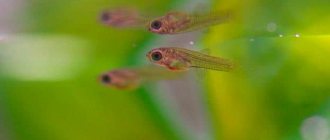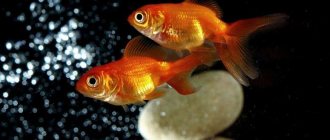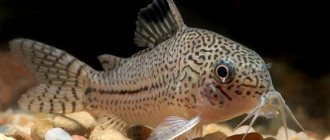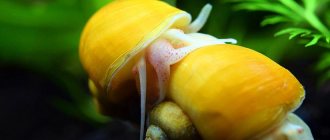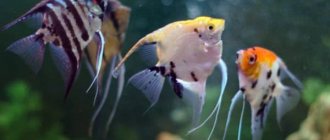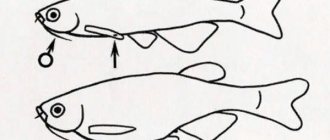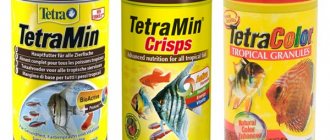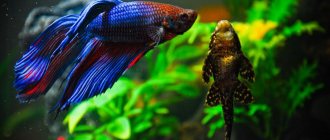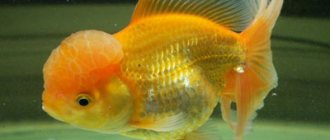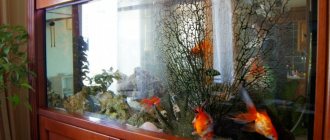Reproduction and breeding of swordtails
Swordtails (Xiphophorus helleri) belong to the family of poeciliid fish. Xiphophorus helleri is translated from Greek as “xiphos” - sword, “phoros” - to carry. The prefix “Helleri” was assigned to swordtails after the German naturalist Karl Bartholomeus Heller, who first caught these fish in Mexican lakes and safely transported them to Europe.
Breeding and propagating swordtails is absolutely not a difficult task . It is similar to the reproduction of guppies and other livebearers. We can say that the reproduction of swordtails actually occurs independently.
Sexual maturity in swordtails occurs at the age of 5-6 months. For breeding (and for their own comfort), it is recommended to keep fish in a ratio of one male to three females. In the process of courting a female, the male performs a kind of courtship dance - shuttle movements back and forth.
Fertilization of mature eggs occurs inside the female. This process may take several days. An interesting feature is that a once fertilized female swordtail can give birth to offspring several more times, even in the absence of a male.
The gestation period of a female swordtail is 4-6 weeks. This period depends on the parameters of the aquarium water, temperature, lighting and feeding.
The pregnant female has a full abdomen and a "black pregnancy spot" under her tail. It is believed that a few hours before giving birth, the female’s belly becomes square, the female begins to move more actively, rushing up and down along the aquarium glass.
pregnant female swordtail
Before giving birth, the female's belly becomes large and a black spot appears near the anal fin.
At one time, the female swordtail spawns from 15 to 100 or more fry. Spawning usually occurs in the morning. With plenty of nutrition and a water temperature of 26-27° C, birth can occur monthly. The key to good breeding and reproduction of swordtails is the absence of nitrogen compounds in the home aquarium.
Preparation for reproduction
Successful breeding of swordtails at home is impossible without proper training of producers. When selecting pairs, all weak and sick fish should be discarded. Strong, viable fry can only be obtained from completely healthy individuals.
The optimal age for breeding is 6-8 months and older. Some females are capable of bearing offspring at the age of 3-4 months, but in most cases, sexual maturity in representatives of this species occurs at 5-6 months. Fish older than 4-5 years should not be allowed into breeding. Producers that are too old produce weak and few offspring.
Housing conditions have a great influence on the number and viability of fry. The water must be clean, without excess nitrogen compounds, and contain enough oxygen. To ensure these conditions, the aquarium is equipped with a filter and an aeration system. It is necessary to replace 1/4 of the aquarium volume with fresh water weekly. In this case, acidity should be maintained at 7-8, and hardness at 10-12°.
An increase in temperature stimulates fish to begin reproduction, so during the period of breeding, the water temperature should be maintained at 24-25°C. It should be taken into account that the sex of future fry depends on the water temperature during the female’s pregnancy. At lower values, more females are born, at higher values, males are born.
To get healthy offspring, it is important to feed the breeders properly. The diet should be varied and include enough animal protein. For this purpose, the fish are regularly fed live and frozen food - bloodworms, daphnia, cyclops, etc. The diet should also contain food of plant origin, made from algae. You should not feed fish expired, poor-quality, mold- or pest-affected food.
Sex differences
It is almost impossible to determine the sex of newborn swordtails, since the young animals do not have pronounced signs. At about 3-6 months of age, it is possible to distinguish a male from a female.
Gender differences are quite noticeable. The following parameters should be taken into account:
- the male has a long growth on the tail, shaped like a sword;
- in the male, the anal fin is quite narrow and pointed;
- females have a paler color;
- in females the anal fin is wider and has a rounded shape;
- the anal fin of the male is tube-shaped and elongated;
- Male fish grow up to 8-10 cm in length, females are larger and can reach 12 cm.
Swordtails belong to a group of fish that can change their gender. This happens if the females find themselves in a same-sex community. As a result, they transform into males. The main factor leading to such a transformation is the threat of extinction.
Pregnancy period
After mating, pregnancy occurs. It can be determined by a number of characteristic features.
Signs of pregnancy
To determine pregnancy, you should look at the female's belly. In a pregnant individual, it is large in size and round in shape; the transition from the head to the abdomen is sharp, in the form of a step, which is why the head appears smaller and more graceful than that of non-pregnant females. Before childbirth, the shape of the abdomen becomes rectangular, and a protrusion appears near the cloaca.
A dark spot appears in front of the anal fin of the fish that bears eggs. In non-pregnant females this area is light. As the eggs develop, the spot enlarges and becomes darker.
How long does pregnancy last
The duration of pregnancy varies for different females and depends on a number of factors:
- temperature and other water parameters;
- duration of daylight hours and lighting intensity;
- quality and composition of the diet;
- the age and health of the female.
On average, pregnancy in swordtails lasts 4-6 weeks.
Behavior before childbirth
The behavior of a pregnant female swordtail changes before giving birth. She loses her appetite, begins to worry, rushes around the aquarium, tries to hide in the thickets of plants. The fish tends to stay near the bottom behind the decorations or in the corner of the aquarium, where it will not be disturbed by other fish. If such signs appear, the female should be placed in the spawning tank as soon as possible in order to avoid eating the born fry by other inhabitants of the aquarium.
The spawning tank is a small aquarium (10-20 liters), where the fry will be raised in the future. When transplanting a female into a separate tank, it must be filled with water from a common aquarium to prevent stress in the fish. A sufficient number of bunches of plants (for example, riccia) floating on the surface of the water should be placed in the spawning tank, in which the born fry will hide.
Birth of fry
Typically, spawning of swordtails begins in the morning. Childbirth lasts from several hours to days. The number of fry that swordtails give birth to at one time can reach 200 pieces. The female gives birth to 1 fry with short breaks. Once born, the fry sink to the bottom or rise to the surface of the water and hide in the thickets of plants. After the end of the birth process, the female must be moved back to the general aquarium as soon as possible so that she does not eat her own offspring.
Mating of swordtails
Swordtails are among the viviparous aquarium fish with internal fertilization. In the male, the anal fin is transformed into a gonopodium (copulation organ). It looks like a narrow and elongated tube.
During mating, the male inserts the gonopodium into the female's cloaca, after which the reproductive products are transferred. They can remain in the female body for quite a long time.
The female is capable of producing offspring 4-5 times after one mating. Even in the case when the male lives separately.
Care of offspring
Swordtail fry need proper care from birth. Their future health and life expectancy depend on the conditions in which they are kept and what food they eat. Proper care of the fry is also necessary in order to avoid their death in the first days of life.
Setting up a spawning tank
For the first time after birth, the fry are kept in a spawning tank. Small-leaved plants (in pots and free-floating) are placed in it, in which the fry can hide. No soil is placed on the bottom. A lamp is placed above the pond. Internal equipment includes a heater that maintains the temperature at 24-25°C and an aeration system. The filter is not installed due to the risk of fry getting inside the device.
On a note! To clean the spawning tank from food debris, you can place a couple of snails.
What to feed swordtail fry
Swordtail fry grow quickly and require a large amount of food. With a lack of nutrients, the fish grow small, with skeletal defects and dull color. In the first days of life, the fry should be fed 4 times a day. After reaching 2 months of age, the fish are transferred to three feedings a day.
Fry can be given:
- Artemia nauplii;
- rotifers;
- microworm;
- cut pipeweed;
- Cyclops;
- dried daphnia ground into powder.
These types of food can be purchased at a pet store or mixed yourself. Purchased live food must be thoroughly washed and inspected for the presence of parasites that may pose a danger to the fry. You should not feed dead or sick invertebrates to fish. Food of animal origin can be given to fish in frozen form, but live invertebrates are preferable for fry.
In the last century, aquarists often used hard-boiled egg yolk to feed young fish. Currently, it is not recommended to give this type of food to fry: it heavily pollutes the water and provokes the proliferation of harmful bacteria. Instead, it is better to use ready-made industrial food for young aquarium fish, as well as feed mixtures for adult fish, ground into powder.
In addition to animal feed, the fry's diet should contain plant products. You can give your fish ready-made flakes containing fiber with the addition of spirulina. Spirulina is necessary for fish for normal growth and the formation of bright colors.
When to replant
While raising the fry, it is necessary to ensure that they always have enough free space for swimming. Fish raised in cramped conditions are often small in size and suffer from curvature of the spine and defects in their fins. Therefore, as swordtails grow, they are periodically sorted and placed in separate containers. The frequency of replanting depends on the size of the spawning tank and the number of fry living in it.
Young fish can be placed in a community aquarium when the fish have reached a sufficient size so that larger neighbors cannot eat them, and also when they are ready to switch to feeding on adult food. This usually occurs at the age of 3-4 months. At the same time, the sex of the fry can be determined and the groups required by the breeder can be formed depending on their morph.
Why don't they reproduce?
To breed fish, the aquarist must create appropriate conditions. If swordtails are stressed, they will not be able to reproduce. We are talking about the presence of aggressive representatives in the aquarium and changes in the characteristics of the aquatic environment. Often fish become stressed when they are moved to another location.
Swordtails are brightly colored fish. In the natural environment, representatives are common in the waters of Mexico and Central America. These fish are easy to care for. Fry are easy to raise, so swordtails are often found in every aquarium. You can buy them at any pet store. Specialized places sell all the necessary equipment to ensure normal growth and development of fish.
Do you have any beautiful swordtails in your aquarium?
If born in a community aquarium
If the owner did not notice changes in the behavior of the female before giving birth and did not remove her, and the fry were born in the general aquarium, they will become easy prey for the rest of its inhabitants, especially if they have a bright red or orange color. Therefore, it is not recommended to breed swordtails in a community aquarium. If newborn fry are found in the aquarium, it is necessary to catch them as soon as possible and transplant them into a spawning tank, where they will subsequently be raised.
If it is not possible to place the fry, you should place in the general aquarium as many dense plants as possible, including floating ones (for example, bunches of riccia), in which the fish can hide. The fish will have to be fed more often, while food for adults is placed in a familiar feeder, and food for fry is evenly distributed over the surface of the water. It is necessary to ensure that the fry have enough food and that it is not all eaten by the adult fish. However, even after taking all possible measures, most of the fry will be eaten by larger neighbors, and only a few individuals will survive.
Causes of infertility
Mating of swordtails does not occur under poor conditions. Infertility can be caused by poor or monotonous diet. These fish often refuse to reproduce in the following cases:
- severe and constant stress caused by overly active, aggressive and large neighbors in the aquarium;
- sudden changes in water parameters in the tank;
- absence of algae and plants in the aquarium;
- various external stimuli.
Often offspring do not appear when the producers are ill or have some genetic defects.
Feeding the young
It is clear how swordtails reproduce, but it is important to properly feed the fry. The period from the first seconds of life to a week of age is the most important in feeding young animals. On these days, it is necessary to leave the light on during the dark and give the young fish plenty of complementary foods with a complete chemical composition, otherwise the fry may grow into weak individuals. Microworms (easy to dilute in grated carrots), crushed oligochaetes, rotifers, and cyclops are suitable as the first food. Live food can be replaced with industrial mixtures. Such concentrates combine all the vitamins and nutrients so necessary for young animals. Also, when breeding aquarium swordtail fish, chicken yolk, regular yogurt, and a special omelet are used for feeding.
As the first food for fry, you can use universal store-bought mixtures for fry.
You can feed the fish with mild cheese. The product is grated on a fine grater and sent in small portions to the aquarium with the fry. Too much feed can spoil the water.
Powdered milk acts as a highly nutritious protein food. You can cook it yourself. A plate of milk is placed in a water bath and evaporated until a dry residue is obtained. The powder is poorly soluble in water and is accessible to fish.
Chicken yolk as food is first ground, a little water taken from the hatchling is added and poured into the fry.
The yolk is an excellent food for bacteria and it quickly pollutes the water, so this food can only be used in case of force majeure. Young fish will not be able to live for long in rotten water, and changing water in large quantities is stressful for the fish.
You can use yogurt to feed the fry. A little curdled milk is poured into boiling water to curdle the casein. The washed protein lumps are placed in a net and placed in the aquarium, shaking slightly. The advantage of this food is that it does not spoil the water. The food should be stored in the refrigerator, but no more than 3-4 days.
Sex ratio
The numerical sex ratio was considered when selecting ornamental fish for cultivation from the natural environment. More research in this area has been carried out on Xiphophorus maculatus than on the swordtail X. helleri (Campton 1989). However, based on the many color variations of swordtails that form hybrids between Xiphophorus maculatus and X. helleri, information has accumulated about the mechanisms of its control. According to Basolo (1990), the sex of Xiphophorus maculatus is determined by the W, X, and Y genes. These genes produce three female genotypes (WX, WY, and XX) and two male genotypes (YY, XY). In swordtails, sexual determination is assumed to be complex, polygenetic and interactive (Basolo 1990). Sex determination of genes shows several chromosomes that interact with each other, and the cumulative expression of genes determines the sex of the fish. An overview of the sex ratios of the five swordtail variations is presented in Table 2. All variations were cultured in aquariums with a diameter of 3.66 meters in one fish farm under general conditions. Observations of sex ratios have shown differences between breeds from an equivalent ratio (1 female/1 male) to a ratio of 4 females/1 male. An even greater asymmetry in the distribution of 9 females/1 male was observed among some farmers. Obviously, the sex ratio is partly related to the breed of the swordtail.
| Aquarium | Variation | Female |
Compatibility
Old males can attack other fish, but this depends on the individual. Some live quite peacefully, while others become violent.
Aggression is promoted by cramped aquariums without plants. What you definitely shouldn't do is keep two or more males in one aquarium. This leads to guaranteed fights. Males tend to be aggressive towards each other, so smaller tanks only keep one male.
A larger tank can accommodate more males - make sure the ratio is one male to four females.
Who do they get along with? With viviparous animals: guppies, platies, mollies. They get along well with a variety of spawning fish: angelfish, gouramis, neons, and irises.
But it’s better not to keep them with goldfish...
Gold requires colder water, and swords are restless neighbors. Swordtails can become timid if kept with aggressive fish and will hide among plants and decor.
You must avoid aggressive species that can attack and injure your swordtails. This rules out most cichlids such as the diamond or black banded cichlids.
Swordtails are not gregarious, but they are sociable and love to be in a group of their own kind.
How do swordtails give birth?
The birth of a swordtail usually begins in the morning. The female gives birth to up to 200 fry. Newborns can be left in the same container with the female. If the fish’s belly has acquired a distinct square shape, and the swordtail begins to move vigorously around the aquarium, then labor will soon begin. Under certain conditions, such as water temperature not lower than 26 degrees and high-quality, plentiful food, reproduction can occur regularly. It is necessary to ensure the presence of bushes in the aquarium in which the female will hide during childbirth.
The fry can be left in the aquarium where they were born until the time comes to mate, after which it is better to separate the swordtails.
Swordfish: description with photos and videos of a popular fish | Pet7
In this article we will talk about aquarium swordtail fish. You will find information about the maintenance, reproduction and types of fish below. In principle, the swordtail is a simple fish, and is perfect for beginner aquarists.
The swordtail is a viviparous fish. The Poeciliidae family, to which it belongs, are peaceful, beautiful and unpretentious fish, very easy to reproduce. They are known to hobbyists all over the world and choosing a flock for a home aquarium will definitely not be a problem.
Aquarium swordtail fish: description, maintenance and care
The swordtail was first described in 1848, and brought to Europe in 1907. The body of the fish is slender, elongated, slightly flattened on the sides.
The hallmark is the elongated lower part of the caudal fin in males, called the “sword”. Hence, in fact, the name of the fish.
However, now there are many different forms that have two swords and a large dorsal fin. The swordtail lives where in Central America there are both standing and flowing bodies of water.
Swordfish
The dimensions of the male and female swordtail fish are different. The male is smaller and more elegant than the female. The female lacks a sword fin.
Dimensions:
- Male - 8-12 cm
- Female - 12-15 cm
The sizes of wild forms are an order of magnitude smaller.
Wild swordtail
The color of swords in nature ranges from lemon yellow to greenish. A reddish stripe runs along the lateral line. The edge of the sword in males is black. Surprisingly, sometimes female swordtails are able to transform into fully productive males.
How long do swordtails live? The lifespan of a viviparous fish is up to five years.
The swordtail is an aquarium fish that anyone who decides to plunge into the wonderful world of aquariums can handle. She is so undemanding that caring for her is as easy as shelling pears.
The fish needs:
- Water temperature - 20-25 degrees (they tolerate short-term drops to 16 °C well)
- Aquarium volume - at least 6 liters per couple, preferably elongated
- Water hardness - dH 8-25°
- Water acidity - pH 7-8
- Regular 30% water changes
- Aeration (with a large volume and a small number of inhabitants, you can get by)
- Aquarium lid/glass - fish may jump out
- Optional addition of sea salt - 1 tbsp. l. for 10 l. water
Feeding swordtail fish is not difficult. They accept almost any food:
- Cyclops
- Daphnia
- Bloodworm
- Tubifex
- Koretru
- Dry food
- Fresh or frozen food
- Spinach
- Powdered oatmeal
- Peas
- Salad
- Nettle
Adding plant foods is a must!
If you have to go somewhere for a long time, you won’t have to worry about fish for up to 2 weeks. They tolerate hunger strike well, feeding at this time on algal formations on plant leaves, glass and soil. They can even eat small snails by shaking out their shells. So go to the seas calmly - some aquarium fish even benefit from such a shake-up.
It is preferable to use dark soil for fish, as they will look more contrasting and beautiful on it. Of course, plants are necessary in an aquarium. You can choose almost any of them to suit your taste. We suggest planting plants for guppies.
They look good in a jar and, perhaps, in addition to the swords, you will also buy guppies, since these species get along well together. However, to ensure that the guppy's fins are not damaged, sufficient volume is needed.
You should not densely plant the pond with plants - swordtails simply need it to make “dispersal”.
You need to remember the rule: if you keep fish in warm water, then there should be more males. If it's cold, the majority are females.
As you can see, keeping aquarium swordtails does not cause problems. In return, you will get the opportunity to admire these beautiful fish, which is useful for relieving the stress that our crazy world is full of.
Compatibility of swordtails with other fish
I repeat that the swordfish is a peaceful fish, which should be planted in the same jar with the same peaceful fish. However, sometimes swordsmen squabble among themselves. This is mainly due to the small number of females. It is recommended to count more than two females per male. And the number of males should be more than two in order to disperse the attention of rivals.
Swordtails are compatible with guppies
Suitable fish to keep with swordtails are:
- Guppy
- Gourami
- Danio
- Discus
- Labeo
- Mollies
- Cockerels
- Pecilia
- Plecostomus
- Rainbows
- Rasbory
- Angelfish
- Tetras
Here you need to look at the displacement of the aquarium. If your bank is like Tokyo, there will probably be problems.
Limited compatibility with:
- Axolotls
- Barbs
- Shrimp
- Sword bearers
- Acne
Completely incompatible with:
- American and African cichlids
- Astronotuses
- Goldfish
- Koi carp
These cute fish will happily eat the swordtail, so it is better to stay away from them. Compatibility chart of the swordtail with other fish
Breeding swordtails at home for beginners
Since this is a viviparous fish, any beginner can cope with the reproduction of swordtails at home. When good conditions are created, mating usually occurs in a common aquarium. What does a pregnant female swordtail look like? Her belly takes on a rounded shape and, as she approaches childbirth, becomes angular, as if square.
Before giving birth, the female swordtail tries to retire in the midst of plants, and by this sign one can determine the beginning of the process. At this time, the female needs to be placed in another vessel with small-leaved plants. Unless, of course, you intend to preserve your offspring.
By the way, a once fertilized female can bring fry several times without the participation of a male.
Pregnant female swordtail
The fry are born after about 40 days. A large female is capable of giving birth to about a hundred or more fry. They are fully formed and can immediately begin to feed.
What to feed swordtail fry in the first days? Children eat small, protein-rich food:
- Artemia
- Cut tubifex
- Nematodes
- Boiled yolk
- Industrial feed for fry
Malek
That's all the wisdom. You can transplant the fry into a common jar when they cannot be eaten by the older inhabitants.
Types of swordtails
There are quite a large number of modifications of swordtails. Since fish reproduce easily, it is easy to obtain new species with varied colors and beautiful fins.
Pineapple swordtail . It is distinguished by a light yellow body with darker, turning into red-brown fins
A fish with a delicate color
Berlin swordtail. This fish was brought to us during the Soviet Union. It is distinguished by short black fins that seem to puff up. The color is either red or orange.
Contrast always looks interesting
The Santa Claus swordtail was obtained by crossing green brothers and platies with a red color. The ideal color is when the middle of the body is white and the ends of the fish are red-orange.
Unusual and beautiful
Heller's green swordtail. This is the direct natural form of the fish from which all other species originated. The form is named after Karl Bartholomew Heller, who discovered it.
the progenitor of all swordsmen
Cuban swordtail (tuxedo). The fish is a hybrid of the green sword and the tuxedo platy, from which it got its unusual coloring. The fish got its name “Kbinsky” because it was brought to the country by diplomats working on Liberty Island.
Red and black - the perfect combination
Calico swordtail. Again a morph of green and platy. Characterized by the presence of white, red, yellow, gray and black spots on the body.
Fun colors
Swordbearer ruby (red). A very beautiful fish. It was bred as a result of long-term crossing with red platies.
King in an aquarium
Koi swordtail. A breeding form that is distinguished by the color of koi carp - red and white spots throughout the body.
Like carp, only swordtail
The forked swordtail was obtained by crossing the lyretail and the flag. A distinctive feature is a tail fin with two swords.
Royal beauty
Black swordtail. The body color is black; the fins may have colorless or yellow zones.
"Dark-skinned" swordtail
Flag swordtail. Feature: elongated dorsal fin.
Fish with a sail
: swordtail
Source: https://pet7.ru/akvariumnye-rybki-mechenostsy-opisanie-soderzhanie-razmnozhenie-i-vidy/
Diseases: prevention and treatment
Every aquarist should carefully monitor the behavior of their pets and their external condition. Most diseases that have not reached a severe stage can be cured, so it is important to identify them as early as possible. Infected fish are immediately transplanted into a quarantine tank.
It is important! Fungal diseases of swordtails are treated with fungicides, bacterial diseases with antiseptic drugs. Fish also tolerate salt baths well.
Injuries
Sword bearers can be injured during fights with rivals or injured on the edges of decorations and equipment. To avoid inflammation and infection through wounds, add hydrogen peroxide (2.5 - 5 ml per 10 l) or streptocide to the aquarium according to the instructions.
Chlorine poisoning
Being active fish, swordtails consume a lot of oxygen. Active breathing can lead to the accumulation of chlorine in the body and, as a result, to intoxication.
Signs of poisoning:
- lethargy;
- yellowness of the gills and mucus on them;
- the fish are trying to jump out.
Letting the water settle before changing or starting the aquarium, as well as using air conditioners, will help you avoid unpleasant consequences. You can control the level of the substance using a chlorometer: ideal indicators for swordtails would be 0.03 - 0.05 milligrams of chlorine per liter.
Poisoned fish are transplanted into a clean tank until the water in the main aquarium is renewed.
Ichthyophthiriasis, or semolina
Sudden changes in temperature or too cold water can lead to the appearance of semolina. Then the swordtails begin to itch on any surface, and a whitish coating, similar to semolina, appears on their scales.
The causative agent of the disease is the ciliate. This is a completely natural inhabitant of aquariums, but the swordtail with weak immunity becomes a breeding ground for this simple organism.
The first step to recovery is to gradually increase the water temperature to the upper limit of normal and relieve the fish of stress. If this measure does not help, you should start treatment with a solution of malachite green. Swordtails tolerate this drug without problems.
Chilodenellosis
The most common disease among swordtails. It is caused by a parasitic ciliate, Chilodonella. The first symptoms of infection are low activity, freezing of the individual, and refusal to feed. The swordtail's fins droop, and a gray coating appears on the back.
Antiprotozoal drugs will help get rid of chylodenalosis. Sick swordtails are moved to a quarantine tank.
Mycobacteriosis
One of the most dangerous diseases for aquarium swordtail fish. It is not easy to identify, since the first signs are similar to the symptoms of other diseases: the pet becomes passive, loses appetite, and gets lost in space. At a later stage, black spots and ulcers appear on the body.
Before the onset of complete fading and the appearance of serious abscesses of the swordtail, you can try to treat it with copper sulfate, trypoflaive or minocycline. At advanced stages, the fish die.
Fin rot
The infection can affect both adult swordtails with weak immunity and fry. Externally, the disease manifests itself in the gradual destruction of the fins. Until the infection penetrates the body and affects its nervous system, the fish is treated in containers with a weak solution of methylene blue (the color of the water should be pale turquoise) or salt (1 tablespoon per 10 liters). If these drugs do not help, you need to use chloramphenicol (1 tablet per 20 liters).
